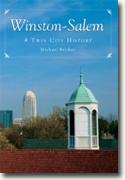Winston-Salem
Michael Bricker
book reviews:
· general fiction
· chick lit/romance
· sci-fi/fantasy
· graphic novels
· nonfiction
· audio books
· author interviews
· children's books @
curledupkids.com
· DVD reviews @
curledupdvd.com
newsletter
win books
buy online
links
home
for authors
& publishers
for reviewers

 |
Winston-Salem: A Twin City History Michael Bricker The History Press Paperback 160 pages May 2008 |
|
Although the history of a single town may not be of interest to everyone, this is a well-crafted story of an unique and uniquely American community, a story of immigrants seeking religious freedom and farmers seeking agricultural wealth within a changing landscape of cultural restrictions.
The Moravians who took up residence in central Piedmont North Carolina were devoted to their beliefs and to a sense of rightness and order in everything they undertook. Hence they built the village of Salem in orderly fashion. As author Michael Bricker puts it, "combining this social order with a meticulous eye for detail, Moravians were always prepared for what lay ahead." The success of their small colony can be attested to in the fact that many of the buildings they constructed still stand, comprising a little village redolent of a time three centuries ago when a different social structure prevailed and all property was respected and well-kept. Salem is now part of the National Park Service. Tours are available to visitors through the demonstration industries and businesses that would have been part of the early settlement. Winston was a different kind of place, mainly given over to large farms. As time went by, the area found its specialty in tobacco cultivation. The morality of the Winston region differed somewhat from that of the strict Moravian colony, and for a time the two cultures were separate but equal, trading back and forth but in large part ignoring one another. The Moravians fought to maintain their unusual Christian sect as the larger world encroached. They established their own schools but eventually opened them up to the townspeople. Other more mainstream religions began to predominate and the Moravian Church became more of an oddity, retaining old customs that were considered colorful but not meaningful to the outsiders of Winston. Yet the Moravians were organized and able to lead. For a while Salem was the dominant town. But eventually, the two cultures merged, with a polite hyphen to denote their unique and separate interests. The city of Winston-Salem has a sprawling medical community which dominates the mid-town landscape. Wake Forest University Medical facilities and "Baptist" Hospital are noted for research and treatment, second perhaps only to Duke University in the South for the extent of their clinical outreach and ultra-modern technology. There is a history of philanthropy that accounts for not only these medical facilities but also a vast network of charities, many of them founded on tobacco money. The Bowman Gray School of Medicine was endowed by the eponymous president of a tobacco company. In recent years, Winston-Salem is putting on a new face, trying like so many small American cities to revitalize its downtown with arts initiatives to get people back on the streets again as they once were in the town's heyday, back when tobacco was king. Nonetheless, the downtown is buttressed along its periphery with large tobacco processing plants that now serve no purpose. Some efforts are being made to convert these large loft-type spaces into urban condos. The city has good greenway trails and many parks, and its fair share of hip dining places - not bad for a region that was once the shared dominion of unschooled farmers and strict puritanical religionists. Full of well-chosen black-and-white photos and a lively text, this book will be of interest to students of Americana and residents of the Carolina Piedmont. Originally published on Curled Up With A Good Book at www.curledup.com. © Barbara Bamberger Scott, 2008 |
|
|
|
 Click here to learn more about this month's sponsor! |
|
| fiction · sf/f · comic books · nonfiction · audio newsletter · free book contest · buy books online review index · links · · authors & publishers reviewers |
|
| site by ELBO Computing Resources, Inc. | |
 The original settlers of Salem, North Carolina, were Moravians who came from Europe and at first found a home in Pennsylvania. Count Nicolas Ludwig Von Zinzendorf was arguably the founder of what is now known as the Moravian Church. With much in common with the Quakers, the Count believed that Jesus Christ could be shared with and found within all people, so he worshipped and evangelized among the lowly, including the Native Americans and newly arrived African slaves. Quite a radical stance in the late 1700s.
The original settlers of Salem, North Carolina, were Moravians who came from Europe and at first found a home in Pennsylvania. Count Nicolas Ludwig Von Zinzendorf was arguably the founder of what is now known as the Moravian Church. With much in common with the Quakers, the Count believed that Jesus Christ could be shared with and found within all people, so he worshipped and evangelized among the lowly, including the Native Americans and newly arrived African slaves. Quite a radical stance in the late 1700s.